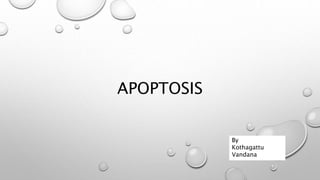APOPTOSIS
•Download as PPTX, PDF•
0 likes•20 views
Programmed Cell death || Apoptosis || Necrosis || Phagocytosis || Necrosis || Ligands || Receptors|| Genetics || Cell biology || Molecular Biology || Cell types || Cellular types || cell shrinkage || Initiation Caspases || Microbiology || Genetics ||Cell types || Necrosis vs apoptosis
Report
Share
Report
Share

Recommended
More Related Content
Similar to APOPTOSIS
Similar to APOPTOSIS (20)
physiology of apoptosis first year mbbs medical.pdf

physiology of apoptosis first year mbbs medical.pdf
Recently uploaded
Antibiotics are medicines that fight infections caused by bacteria in humans and animals by either killing the bacteria or making it difficult for the bacteria to grow and multiply. Bacteria are germsABHISHEK ANTIBIOTICS PPT MICROBIOLOGY // USES OF ANTIOBIOTICS TYPES OF ANTIB...

ABHISHEK ANTIBIOTICS PPT MICROBIOLOGY // USES OF ANTIOBIOTICS TYPES OF ANTIB...ABHISHEK SONI NIMT INSTITUTE OF MEDICAL AND PARAMEDCIAL SCIENCES , GOVT PG COLLEGE NOIDA
Recently uploaded (20)
GBSN - Microbiology (Unit 7) Microbiology in Everyday Life

GBSN - Microbiology (Unit 7) Microbiology in Everyday Life
Costs to heap leach gold ore tailings in Karamoja region of Uganda

Costs to heap leach gold ore tailings in Karamoja region of Uganda
Continuum emission from within the plunging region of black hole discs

Continuum emission from within the plunging region of black hole discs
Mining Activity and Investment Opportunity in Myanmar.pptx

Mining Activity and Investment Opportunity in Myanmar.pptx
ABHISHEK ANTIBIOTICS PPT MICROBIOLOGY // USES OF ANTIOBIOTICS TYPES OF ANTIB...

ABHISHEK ANTIBIOTICS PPT MICROBIOLOGY // USES OF ANTIOBIOTICS TYPES OF ANTIB...
X-rays from a Central “Exhaust Vent” of the Galactic Center Chimney

X-rays from a Central “Exhaust Vent” of the Galactic Center Chimney
GBSN - Microbiology (Unit 6) Human and Microbial interaction

GBSN - Microbiology (Unit 6) Human and Microbial interaction
Factor Causing low production and physiology of mamary Gland

Factor Causing low production and physiology of mamary Gland
Manganese‐RichSandstonesasanIndicatorofAncientOxic LakeWaterConditionsinGale...

Manganese‐RichSandstonesasanIndicatorofAncientOxic LakeWaterConditionsinGale...
Isolation of AMF by wet sieving and decantation method pptx

Isolation of AMF by wet sieving and decantation method pptx
APOPTOSIS
- 2. INTRODUCTION: • Cell death by injury -mechanical damage -exposure to toxic chemicals • Cell death by suicide -internal signals -external signals • Apoptosis or programmed cell death, is carefully coordinated collapse of cell, protein degradation, DNA fragmentation followed by rapid engulfment of corpses by neighboring cells. • Essential part of life for every multicellular organism from worms to humans. • Apoptosis plays a major role from embryonic development to senescence.
- 3. WHAT MAKES A CELL DECIDE TO COMMIT SUICIDE? • Withdrawal of positive signals examples: 1. Growth factors for neurons 2. Interleukin-2 (IL-2) • Receipt of negative signals examples: 1. Increased levels of oxidants within the cell 2. Damage to DNA by oxidants 3. Death activators: a. Tumor necrosis factor alpha (TNF- ) b. Lymphotoxin (tnf-β) c. Fas ligand (fasl)
- 7. MORPHOLOGICAL EVENTS: 1. Cell shrinkage 2. Organelle reduction 3. Mitochondrial leakage 4. Chromatin condensation 5. Nuclear fragmentation 6. Membrane blebbing & changes
- 9. REGULATION OF APOPTOSIS: • Stimuli → apoptosis → selection of targets • Apoptosis by conflicting signals that scramble the normal status of cell • Apoptotic stimuli → cytokines, death factors (fasl) • DNA breaks → p53 is activated → arrest cell cycle or activate self- destruction.
- 10. IMPORTANCE OF APOPTOSIS: • Important in normal physiology / development A. Development: immune systems maturation, morphogenesis, neural development B. Adult: immune privilege, DNA damage and wound repair. • Excess apoptosis A. Neurodegenerative diseases • deficient apoptosis A. Cancer B. Autoimmunity
- 11. CONCLUSION: • An important process of cell death • Can be initiated extrinsically through death ligands (e.G., TRAIL, fasl) activating initiator caspase 8 through induced proximity. • Can be initiated intrinsically through dna damage (via cytochrome c) activating initiator caspase 9 through oligomerization. • Initiator caspases 8 and 9 cleave and activate effector caspase 3, which leads to cell death.
- 12. THANK YOU